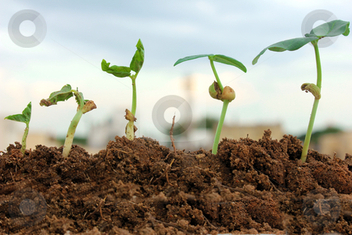CHAPTER 15: PLANT GROWTH AND DEVELOPMENT
 Growth:
Growth:- It is a characteristic of living beings in which an irreversible permanent increase in size of an organ or its parts occur or an increase in the size of a cell.
- Growth rate can be defined as the increase in growth per unit time.
- Plants show two types of growth—Arithmetic and Geometric—according to the increase shown by the growth rate.
- Arithmetic growth - Only one daughter cell continues to divide while others differentiate or mature. Example − root elongating at a constant rate.
o Geometric Growth - Initial growth is slow (lag phase), followed by a rapid increase in growth (log/exponential phase), and followed by a phase where growth slows down (stationary phase). Example − all cells, tissues and organs show this type of growth
Conditions for Growth
- Include: water, oxygen, nutrients and temperature.
- Differentiation
- In this process, cells derived from root apical and shoot apical meristems and cambium differentiate and mature to perform specific functions.
- Dedifferentiation
- Process in which living differentiated cells regain their capacity to divide
- Redifferentiation
- Process in which differentiated cells that have lost their ability to divide are reformed from dedifferentiated cells and have the ability to perform specific functions.
· Development – changes in the life cycle.
· Plasticity – different kinds of structure in response to environment or phases of life.
· Eg. Heteropylly in cotton and coriander. In these plants, leaves have different shapes based on the phase of life cycle as well as the habitat.
· Development can also be termed as − growth + differentiation
- Development is controlled by intrinsic as well as extrinsic factors.
- Intrinsic − Genetic factors and plant growth regulators
- Extrinsic − light, temperature, water, oxygen, etc.
Classification based on their nature of action:
· Plant growth promoters. – Auxins, Gibberellins and Cytokinins.
· Plant growth inhibitors - Absissic acid (ABA)
- Ethylene may fit in either of the two groups, but is largely an inhibitor.
· Auxins
· Gibberellins
· Cytokinins
· Ethylene
· Abscisic acid
Auxins
Discovery :– auxins were discovered by Charles Darwin and Francis Darwin.
Isolation :– they were isolated from tips of coleoptiles of oat seedlings by F.W.Went as IAA and IBA.
Effects: –
· Initiate rooting in stem cuttings, plant propagation.
· Promote flowering, prevent fruit anf leaf drop.
· Promote abscission of older mature leaves.
Uses:-
· Induce parthenocarpy
· Widely used as herbicides (2,4 – D)
· To kill dicotyledonous weeds
· Prepare weed free lawns.
· Controls xylem differentiation and helps in cell division
Gibberellins
Discovery : E. Kurosawa identified gibbereilins present in a fungal pathogen Gibberella fujikuroi
Isolation: Infected rice seedlings when treated with sterile filtrates of fungus
Effects:
· GA’S are acidic.
· Increase in length, cause fruits to elongate and improve its shape.
· Delay senescence, extend the market period.
· GA3 used to speed up malting process in brewing
Uses:
· Spraying sugarcane crop with this
· Increases length of stem
· Fastens maturity period.
· Promotes bolting
Cytokinins
Discovery : Skoog and Miller
Isolation: Crystallized it promoting active substance named it kinetin from coconut milk, corn – kernels.
Effects:
· They are synthesized where rapid cell division takes place
· Produce new leaves, chloroplasts in leaves, lateral shoot growth and adventitious shoot formation.
Uses:
· Help overcome apical dominance
· Promote nutrient mobilization which helps in the delay of leaf senescence
Ethylene (gaseous hormone):
Discovery : Cousins confirmed the release of a volatile substance from ripened oranges that hastened the ripening of stored un ripened bananas
Effects:
· Promotes senescence and abscission
· Highly effective in fruit ripening
· Enhances the respiration rate
· Breaks seed and bud dormancy
· Initiates germination in peanut seeds.
· Sprouting potato tubers, promotes root growth root hair formation
Uses:
· Used to initiate flowering, for synchronizing fruit, induces flowering, regulates physiological processes.
· Hastens fruit ripening, accelerates abscission and Promotes female flowers.
Abscisic Acid (ABA):
Discovery: Researchers.
Isolation: 3 kinds of inhibitors - Inhibitor – B, abscission ll & dormin.
Effects:
· Regulates abscission dormancy
· ABA stimulates the closure of stomata
· Increases tolerance, seed development
· Maturation, dormancy, withstand desiccation
Uses:
· There are no. of events in a plant
· Where more than one PGR interact to affect that event, example - Dormancy in seeds / buds abscission, senescence, apical dominance.
Photoperiodism
- It is the response of plants to periods of day/night
- Some plants require periodic exposure to light to induce flowering. Duration of dark period is equally important for flowering.
Short Day Plants − Plants that require exposure to light for a period less than this critical period to induce flowering.
Day Neutral Plants − Plants where there is no correlation between exposure to light duration and induction of flowering.
Vernalization
- It is the phenomenon of dependence of flowering on exposure to low temperature.
- Example − Biennial plants
These are monocarpic plants that flower and then die in second season. Some examples are sugar beet, cabbage, carrot, etc.